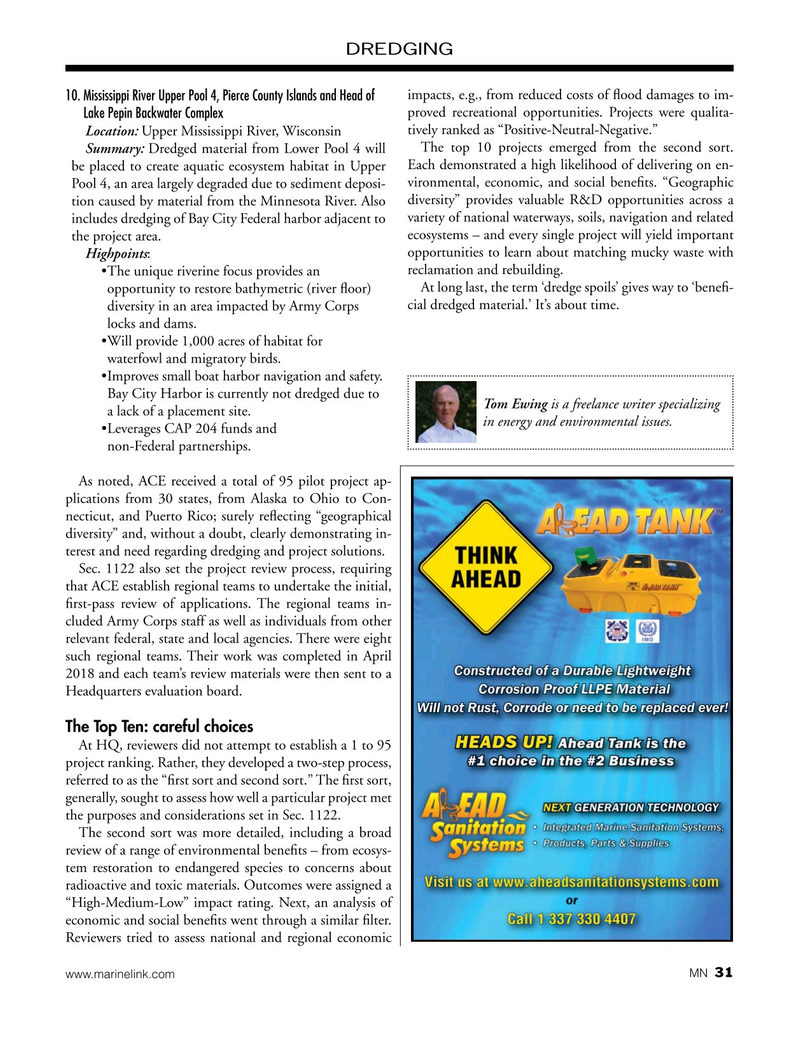
Page 31: of Marine News Magazine (February 2019)
Dredging & Marine Construction
Read this page in Pdf, Flash or Html5 edition of February 2019 Marine News Magazine
DREDGING 10. Mississippi River Upper Pool 4, Pierce County Islands and Head of impacts, e.g., from reduced costs of food damages to im- Lake Pepin Backwater Complex proved recreational opportunities. Projects were qualita-
Location: Upper Mississippi River, Wisconsin tively ranked as “Positive-Neutral-Negative.”
Summary: Dredged material from Lower Pool 4 will The top 10 projects emerged from the second sort. be placed to create aquatic ecosystem habitat in Upper Each demonstrated a high likelihood of delivering on en-
Pool 4, an area largely degraded due to sediment deposi- vironmental, economic, and social benefts. “Geographic tion caused by material from the Minnesota River. Also diversity” provides valuable R&D opportunities across a includes dredging of Bay City Federal harbor adjacent to variety of national waterways, soils, navigation and related the project area. ecosystems – and every single project will yield important
Highpoints: opportunities to learn about matching mucky waste with • The unique riverine focus provides an reclamation and rebuilding.
opportunity to restore bathymetric (river foor) At long last, the term ‘dredge spoils’ gives way to ‘benef- diversity in an area impacted by Army Corps cial dredged material.’ It’s about time. locks and dams.
• Will provide 1,000 acres of habitat for waterfowl and migratory birds.
• Improves small boat harbor navigation and safety. Bay City Harbor is currently not dredged due to
Tom Ewing is a freelance writer specializing a lack of a placement site.
in energy and environmental issues.
• Leverages CAP 204 funds and non-Federal partnerships.
As noted, ACE received a total of 95 pilot project ap- plications from 30 states, from Alaska to Ohio to Con- necticut, and Puerto Rico; surely refecting “geographical diversity” and, without a doubt, clearly demonstrating in- terest and need regarding dredging and project solutions.
Sec. 1122 also set the project review process, requiring that ACE establish regional teams to undertake the initial, frst-pass review of applications. The regional teams in- cluded Army Corps staff as well as individuals from other relevant federal, state and local agencies. There were eight such regional teams. Their work was completed in April 2018 and each team’s review materials were then sent to a
Headquarters evaluation board.
The Top Ten: careful choices
At HQ, reviewers did not attempt to establish a 1 to 95 project ranking. Rather, they developed a two-step process, referred to as the “frst sort and second sort.” The frst sort, generally, sought to assess how well a particular project met the purposes and considerations set in Sec. 1122.
The second sort was more detailed, including a broad review of a range of environmental benefts – from ecosys- tem restoration to endangered species to concerns about radioactive and toxic materials. Outcomes were assigned a “High-Medium-Low” impact rating. Next, an analysis of economic and social benefts went through a similar flter.
Reviewers tried to assess national and regional economic 31 www.marinelink.com MN

 30
30

 32
32
